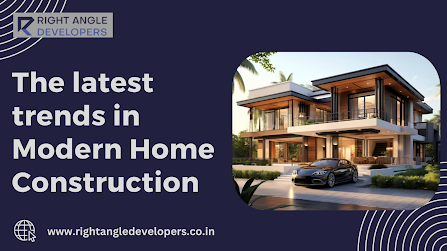The five most innovative technologies in home building for the future
Introduction:
The future of homebuilding is full of exciting possibilities as technological advancements continue to reshape the homebuilding industry. Building a home is no longer just about bricks. It's about integrating smart technology and sustainable solutions to create spaces that are not only functional but also eco-friendly and energy-efficient. Here are the five most innovative technologies that will revolutionize homebuilding in the coming years.
1. 3D Printing in Construction:
3D printing, or additive manufacturing, is changing the way homes are built. This technology involves creating structures layer by layer using 3D printers that can use materials such as concrete, plastics, and composites.
Speed and efficiency: Traditional construction can take a long time, but 3D printing speeds up the process significantly. An entire house can be printed in days, rather than weeks or months using traditional methods.
Cost-effective: 3D printing can reduce overall construction costs by reducing labor costs and material waste. The technology allows for precise control of material consumption, minimizing waste and reducing costs.
Customization: 3D printing allows for highly customized designs and intricate architectural details that would be difficult or impossible to achieve using traditional methods. Advances in technology will soon make 3D printing a common practice in home construction, allowing for the creation of affordable, unique, and environmentally friendly homes.
2. Smart Home Technology:
Smart home technology is rapidly evolving, giving homeowners unprecedented control over their living environment. From advanced security systems to energy management, smart home technology improves comfort, security, and efficiency.
Integrated Systems: Modern smart homes feature integrated systems that allow homeowners to control lighting, climate, security, and appliances from a single interface, often via a mobile app or voice assistant.
Energy efficiency: Smart thermostats, lighting systems, and energy monitors help optimize energy consumption, reduce electricity bills, and minimize environmental impact. For example, smart thermostats learn occupant preferences and adjust temperatures accordingly, resulting in more efficient heating and cooling.
Improved security: Smart security systems include features such as real-time video surveillance, motion detectors, and automatic locking mechanisms. These systems enhance security by allowing homeowners to monitor and manage their security remotely.
With the continued development of smart home technology, we can expect even more sophisticated systems that will further improve the functionality and efficiency of living spaces.
3. Green Building Materials:
Sustainability is becoming increasingly important in home construction, and green building materials are at the forefront of this movement. These materials are designed to reduce environmental impact, improve energy efficiency, and promote healthier living environments. Notable green building materials include:
Recycled Materials: Recycled steel, glass, and plastics can be used in construction, reducing the need for raw materials and minimizing waste. For example, recycled steel is used in structural elements, and recycled glass can be incorporated into tiles and countertops.
Sustainable Wood: Wood from sustainably managed forests, such as bamboo and reclaimed wood, offers an eco-friendly alternative to traditional wood. Not only are these materials environmentally friendly, but they also add beauty value to a home.
Eco-Friendly Insulation: Insulation materials such as cellulose and spray foam improve energy efficiency and reduce a home's carbon footprint.
Eco-friendly building materials are becoming more readily available and affordable, making it easier for builders to incorporate sustainable practices into their projects.
4. Building Information Modeling (BIM):
Building Information Modeling (BIM) is a digital technology that allows architects, engineers, and construction companies to create detailed 3D models of buildings. These models contain information about the physical and functional characteristics of the structure and offer several benefits:
Improved collaboration: BIM facilitates communication and coordination between project stakeholders by providing a common digital model. This reduces errors and conflicts during construction, making the building process smoother.
Improved efficiency: BIM allows for accurate planning and simulation of the construction process, helping to identify potential problems before they occur.
Lifecycle Management: BIM goes beyond construction to support the management of buildings throughout their lifecycle. The model can be used for maintenance, renovation, and building management, providing valuable data for long-term planning.
BIM is becoming an essential tool in modern architecture, providing an approach to the design and management of buildings.
5. Introducing renewable energy:
As the drive towards sustainability continues, the integration of renewable energy sources into homes is gaining momentum.
Renewable energy technologies include:
Solar Panels: Photovoltaic (PV) panels convert sunlight into electricity, providing a clean, renewable energy source for your home. Advances in solar panel technology have increased efficiency, reduced costs, and made solar energy more accessible.
Wind Turbines: Small residential wind turbines can generate electricity from the wind to complement solar energy systems. These turbines are especially useful in areas with stable wind patterns.
Geothermal Systems: Geothermal heating and cooling systems use the earth's stable temperature to regulate indoor climate.
Integrating renewable energy not only helps reduce electricity bills but also supports a more sustainable and resilient energy future.
Conclusion:
The future of home construction will be shaped by innovative technologies that improve efficiency, sustainability, and quality of life. From 3D printing and smart home technologies to green building materials, BIM, and the integration of renewable energy, these advancements are changing the way homes are designed and constructed. As these technologies continue to develop, we promise to create homes that are not only more comfortable and practical but also more environmentally friendly. Leveraging these innovations will pave the way for a better, more sustainable future for homes. Right Angle Developers provides the top Home Construction Builders in Bangalore.




Comments
Post a Comment